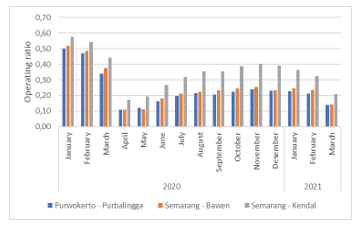The Operational Performance of Mass Transportation Before Covid-19 and New Normal Life: Case Study BRT TransJateng, Central Java
Volume 6, Issue 3, Page No 361-366, 2021
Author’s Name: Juanita Juanita1,a), Titus Hari Setiawan2, Anwar Ma’ruf 3
View Affiliations
1Department of Civil Engineering, Universitas Muhammadiyah Purwokerto, Purwokerto, 53182, Indonesia
2School of Architecture, Planning, and Policy Development, Bandung Institute of Technology, Bandung, 40132, Indonesia
3Department of Chemical Engineering, Universitas Muhammadiyah Purwokerto, Purwokerto, 53182, Indonesia
a)Author to whom correspondence should be addressed. E-mail: juanitamstr@gmail.com
Adv. Sci. Technol. Eng. Syst. J. 6(3), 361-366 (2021); ![]() DOI: 10.25046/aj060342
DOI: 10.25046/aj060342
Keywords: Performance, Operating ratio, BRT services
Export Citations
This article examines the operational performance of Bus Rapid Transit (BRT) before the pandemic and a new normal life. Overview of BRT operational performance in terms of the number of passengers transported, load factor and operating ratio. The method used is to compare the conditions before the pandemic and the new era of life. The findings of overall operations performance have decreased since the pandemic. However, BRT operations services are keep running by prioritizing health protocols. Efforts to control the spread of Covid-19 in BRT operations carried out by the policy steps presented. The government needs effort and consistency with BRT services in community services and strategies to prevent the spread of Covid-19.
Received: 26 April 2021, Accepted: 08 June 2021, Published Online: 27 June 2021
1. Introduction
The development of the city must be in line with the increase in good public transport. The role of the Government needed in improving public transport services. The operation of Bus Rapid Transit (BRT) in Indonesia regulated Law number 22 of 2009 concerning traffic. The BRT a public transport with economy class fares on routes subsidized by the Government or Local Government. Improving public transport performance requires attention to a harmonious subsystem and an increase in infrastructure development, service levels and policy support [1].
December 2019, the first time it identified that Covid-19 an impact on various sectors, especially the transportation sector. The transport sector affects service performance and health risks, financial sustainability, social equality and sustainable mobility [2]. The operational strengths and weaknesses of BRT contribute to overcoming and improving operations [3].
The purpose of the article is to reveal the operational performance of BRT before the pandemic and new normal life in terms of transported passengers, load factor and operating ratio. Implemented policies and efforts made by local government in preventing the spread of Covid-19 that expected to contribute to the planning of BRT development in the adaptation of the new normal life in small and medium-sized cities.
2. Study Context
BRT Trans Jateng is an integrated inter-city bus rapid service in the Central Java Province of Indonesia. BRT services operated under the Central Java Transportation Agency, where the operating system adopts Trans Jakarta and Trans Semarang services. Figure 1 describes the locations where the three BRT routes operate, namely in the province of Central Java. The routes studied here are the Purwokerto – Purbalingga route, the Semarang – Kendal route and the Semarang – Bawen route. The Purwokerto – Purbalingga route as corridor II is in Banyumas Regency which connects the city of Purwokerto to Purbalingga. The Semarang – Kendal route is corridor III continued to the Semarang – Bawen route. In general, the description of the three routes presented in Table 1. The total population of Central Java Province in 2020 is 36,516,035 people. The resident of the regency/city where the BRT operates is Kendal Regency 1,018,505 residents, Semarang Regency 1,053,094 residents, Purwokerto City 229,271 residents and Purbalingga Regency 998,561 residents [4], [5]. Referring to the criterion of small, medium and large cities [7], Purwokerto is in the small city category, while Purbalingga, Semarang and Kendal are in the medium city category.
Population density over time series can assist policymakers in making adjustments to motivate policy effectiveness [6]. BRT operations affect urban development around systems that have high technical and performance characteristics [7]. The principle of developing the Trans Jateng BRT by the Regional Government focuses on the main corridors of two districts/cities so that connectivity built between the main path which can trigger changes in the behavior of private vehicle users to switch to public transportation through public transport services that are better than what was before (paratransit system).
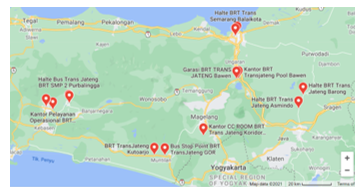 Figure 1: Study area: Central Java Province
Figure 1: Study area: Central Java Province
3. Methods
The paper examines the BRT system in Indonesia, especially in small and medium-sized cities in Central Java Province during the pandemic and the new normal life. The BRT route is in three corridors in three districts/cities which an empirical approach was carry in achieving the research objectives. The stages taken are data collection, data processing and analysis. Data on the number of passengers, load factor, vehicle operating costs and revenue are secondary data obtain from the Central Java Transportation Agency. Comparative data analysis carried to see the comparison between the pandemic era and the new normal, namely the number of passengers transported, load factor and operating ratio. The load factor shows the level of operational effectiveness of the BRT. The low load factor indicates less efficient operation. The operating ratio used to evaluate the impact of BRT operations as an economic indicator [8]. Also, the context of Government policy in providing BRT services during the pandemic and new normal is discussed here as the Government’s efforts to control the spread of Covid-19.
4. Results
4.1. Corridor overview
In general, an overview of the three routes presented in Table 1. The longest operating route from the three corridors is Semarang – Bawen and the most recently operated is Semarang – Kendal. The tariff setting for the three corridors follows a flat-rate system, much closer to the same as IDR 2000 for students and IDR 4000 for public per trip. Moving or transit corridors are subject to applicable fees.
Especially for workers, the tariff is the same as for students. The requirements for passengers must show their employment card, clarified ID Card and work uniform when making payments.
Figure 2 shows the routes and shelters traversed by the Semarang – Bawen and Semarang Kendal routes. In Figure 2 The Semarang – Bawen route (a) connects the city of Semarang from Tawang station to Bawen at the Bawen terminal via 71 shelters.
Table 1: Technical overview of the three BRT routes before the pandemic
| Corridor I | Corridor II | Corridor III | |
| Route | Semarang – Bawen | Purwokerto – Purbalingga | Semarang – Kendal |
| Distance (km)
round-trip |
36,5 |
33,5 |
25,5 |
| Rates (IDR) | Students: 2000
General: 4000 |
Students: 2000
General: 4000 |
Students: 2000
General: 4000 |
| Shelter | 71 | 32 | 47 |
| Total fleet | 26 | 14 | 14 |
| launched operationally | 07 July, 2017 | 13 August, 2018 | 15 October, 2020 |
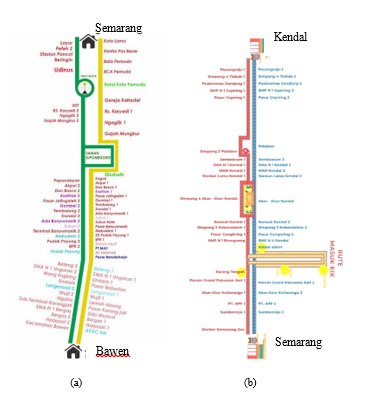 Figure 2: Semarang – Bawen (a) and Semarang – Kendal Routes (b)
Figure 2: Semarang – Bawen (a) and Semarang – Kendal Routes (b)
The Semarang – Kendal route (b) starts / ends from Mangkang Terminal to Bahurekso Terminal. This route serves the Kendal industrial area with 47 bus-stop for boarding and boarding passengers. Meanwhile, Figure 3 the Purwokerto – Purbalingga route through 32 bus-stop. BRT operational performance is in the medium category when viewed from the condition shelters and the traffic space, especially the Purwokerto – Purbalingga corridor [9].
During the pandemic period, to prevent the spread of Covid-19, since April 2020, the Semarang – Bawen route has been changing, especially on Saturdays and Sundays. The closure of the protocol roads was carried out in the city of Semarang by the City Transportation Agency. Some of the bus stops are not active during the transfer, namely the “Balaikota” bus stops. The Semarang – Bawen route for boarding and disembarking passengers are carried out at several bus stops, purchasing tickets on the bus / on the bus stop by officers. Meanwhile, the Purwokerto – Purbalingga route has diverted due to the closure of several roads. The impact is that two bus stops are not functioning. However, since February 27, 2021, all bus stops can functionalize to hop on and off passengers.
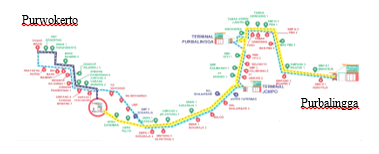 Figure 3: Purwokerto – Purbalingga route
Figure 3: Purwokerto – Purbalingga route
4.2. BRT operational performance
Figure 4, Figure 5, Figure 6 shows the fluctuation of daily passenger in three corridors.
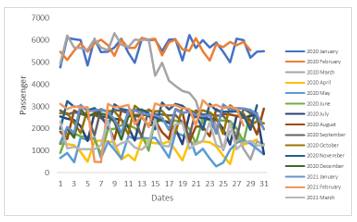 Figure 4: The daily travel in the Semarang – Bawen route
Figure 4: The daily travel in the Semarang – Bawen route
Figure 4 shows daily passenger fluctuations for the Semarang – Bawen route. In March 2020, since the announcement of the first case of Covid-19 in Indonesia, on March 9, the highest daily passengers were 6318 passengers, which decreased drastically to 607 passengers on March 29. But during 2020, the lowest number of passengers transported was 297 passengers on May 24. In 2021, February 24, since the Central Java “stay at home” program, passengers fell drastically and were the lowest on February 7 at 470 passengers, but rose again to reach the highest peak on February 22 at 3292 passengers.
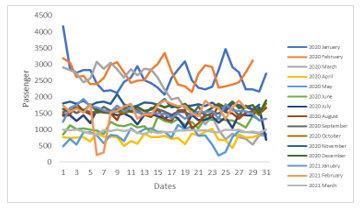 Figure 5: The daily travel in the Semarang – Kendal route
Figure 5: The daily travel in the Semarang – Kendal route
Figure 5 shows the daily passenger fluctuation of the Semarang – Kendal route. The highest number of daily passengers on the Semarang – Kendal route on January 1, 2020, were 4172 passengers. On March 29, 2020, daily passengers reached 539 passengers and reached the lowest position on May 24 at 203 passengers. In 2021, February 6, passengers dropped to 221 passengers but rose again on February 16, at 1902 passengers.
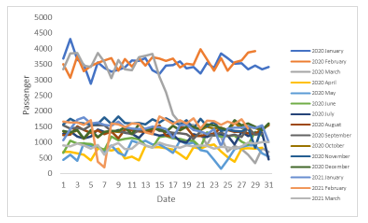 Figure 6: The daily travel in the Purwokerto –Purbalingga route
Figure 6: The daily travel in the Purwokerto –Purbalingga route
Figure 6 shows the daily passenger fluctuation of the Purwokerto – Purbalingga route. In 2020, the highest daily passenger on January 2 was 4304 passengers. On March 29, 2020, daily passengers reached 337 passengers. The lowest position on May 24 was 150 passengers. In 2021, daily passengers hit their lowest point on February 7 at 198 passengers but rose to their highest peak on February 15 at 1828 passengers.
Since the implementation of social distancing, of the three routes, that the lowest passengers, the Purwokerto – Purbalingga route was 150 passengers in May 2020.
Figure 7 shows the total passengers in the three corridors. In Indonesia, since March 2020, the first confirmed case of Covid-19, especially in the three corridors, has resulted in a decrease in the number of passengers. April 2020 saw was the lowest decrease in the number of passengers reaching 63% – 72%. Compared to other countries such as Budapest, Hungary, there is a decrease in demand for public transportation services by 80% [10]. In India, 5.3% of people switch to public transport during the transition period [11].
In 2020, the average demand growth for the Purwokerto – Purbalingga route (- 2%), the Semarang – Bawen route (- 1%) and the Semarang – Bawen route a constant demand trend (0%). The first quarter of 2021 the Purwokerto – Purbalingga route and the Semarang – Bawen route fell 13%, the Semarang – Bawen route fell 18%. The decrease caused by Government policies in controlling the spread of Covid-19 through large-scale social restrictions and preventing crowds. In February 2021, to further reduce the spread of Covid-19, the Central Java program implemented. Transportation services are not closed because they are part of public services. Trans Jateng BRT services both eras presented in Table 2. The policy to restrictions BRT operating hours enforced during the pandemic and the new normal. The restriction operation is from 6 AM to 9 AM and afternoon from 3 PM to 6 PM. Since the policy, there has a 35% decrease in passengers on the Purwokerto – Purbalingga route, a 40% reduction in passengers on the Semarang – Bawen route and a 36% for the Semarang – Kendal route. Headway during morning and evening peak hour around 5 – 10 minutes to anticipate the crowds at shelter and bus.
Table 2: Trans Jateng BRT services
| Pre-pandemic | New normal life | |||||
| Corridor | I | II | III | I | II | III |
| Headway | 10-15 | 10-15 | 10-15 | 5-10 | 5-10 | 5-10 |
| The shift in off-peak operating hours compacted at the peak | 05.30 s/d 19.30 | 05.30 s/d 19.30 | 05.30 s/d 19.30 | 6-9 dan 15-18 | 6-9 dan 15-18 | 6-9 dan 15-18 |
| Max pax | 40 | 40 | 40 | 20 | 20 | 20 |
| Round-trips | 6 | 8 | 6 | 6 | 8 | 6 |
A decrease in demand for BRT services affects the load factor value. Load factor used in considering the optimal number of buses operating [12]. Early 2020, pre-pandemics is the high load factor, was almost 100% for the Semarang – Bawen route, 80% for the Purwokerto – Purbalingga route and 60% for the Semarang – Kendal route.
In Figure 8, since the announcement of residents exposed to Covid-19 in April – May 2020, the load factor has dropped to less than 20% on three routes. To control the spread of Covid-19 in the Trans Central Java BRT, operators must provide bus operational services by paying attention to health protocols.
The implementation of this policy has an impact on increasing load factor starting June 2020. However, the load factor is less efficient from a commercial perspective, low load factor in providing base mobility services during the pandemic and the new era.
BRT revenue in both conditions presented in Figure 9. The highest incomes are in the Semarang – Bawen corridor. Income has fluctuated up and down this influenced by conditions, namely before the pandemic, upper revenues, but entering the pandemic period, it fell drastically while the new life period increased.
 Figure 9: Revenue of BRT in three routes
Figure 9: Revenue of BRT in three routes
The operational costs of the BRT before the pandemic until the new normal have not changed. Based on data from the Central Java Transportation Agency, the operational cost for the Purwokerto route is IDR 7,550 per bus kilometer, the Semarang – Bawen route is IDR 8,375 per bus kilometer and the Semarang – Kendal route is IDR 9,101 per bus kilometer. Therefore, with the route characteristics as in Table 1, the monthly operating charge for the three routes are Purwokerto – Purbalingga IDR 708 million, Semarang – Bawen IDR 1,192 million and Semarang – Bawen IDR 487 million.
BRT operating ratio derived from total revenue divided by operating expenses included depreciation. Cost-benefit analysis used to determine the frequency of bus services and the adequacy of the number of operating fleets [13]. The operating ratio presented in Figure 10. The operating ratio in early 2020 of the three routes highest on the Semarang – Kendal route is 0.58 others reached 0.5. April all routes have the lowest operating ratio. For the 2021 quarter, the operating ratio reached the highest value among other months. Overall, the average operating ratio in each quarter presented in Figure 11. The average operating ratio highest found in the Semarang – Kendal corridor. In 2020 the first quarter of before the pandemic, the average operating ratio was high, then in the second quarter since the pandemic decreased dramatically in the three routes. Since the third and fourth quarters of 2020, the operating ratio has started to increase again. However, since the beginning of 2021 and the implementation of the Central Java “stay at home” policy, the operating ratio decreased. The three routes operating ratio values are less than expected, less than 1.05-1.08 [14].
The value of the three routes shows that the revenue earned has not been able to cover costs and has generated a sufficient surplus in the provision of investment and growth. According to some researchers, subsidized services will lose focus on cost-effectiveness and market orientation [15].
 Figure 11: The average of operating ratio in each quarter
Figure 11: The average of operating ratio in each quarter
However, because BRT buses are a subsidized service, the focus is on fulfilling community services regardless of the advantages and disadvantages. Here, good public transport services stimulate community development on easy accessibility [16].
4.3. BRT Trans Jateng operational policy
Pandemics have broad social and economic impacts [17]. Control of the spread of Covid-19 carried out to provide healthy transportation services. Health-related safety perceptions of mode choice did not significantly influence modal choice decisions [11]. A pandemic is a test run of a future crisis and an opportunity to introduce discussions on the new green and public mobility paradigm [18]. The Indonesian government has launched various policies, enforced health protocols, and enforced sanctions. The impact of Covid-19 on public transport requires the need to adjust strategic, tactical and operational planning steps [19]. The enforcement of interventions at levels (border control measures, community transmission control measures and case-based control measures are effective [20]. Control of passenger transportation carried out during travel preparation, during the trip and until the destination or arrival [21]. The Central Java Transportation Agency handles the control of the spread of Covid-19, including:
- BRT operators maintain cleanliness and spray disinfectants on fleets at the first departure terminal minimum three time a day.
- Operators are required to provide masks for the BRT crew.
- The operator is obliged to provide tissue on the bus.
- The operator must educate passengers about the dangers and ways of preventing the coronavirus.
Efforts to control the spread of Covid-19 in the provision of BRT services carried out in stages since it announced that residents were exposed to Covid-19, as shown in Figure 12. The handling of Covid-19 starting March 2020 will impose a maximum passenger restriction of 35 people as an effort of physical distancing policy. But starting March 21, the maximum passenger limit is 20 people. Physical distancing is carried out at bus stops and on buses by keeping a minimum distance of 1 meter. Efforts to comply with physical distancing and the make use of masks, especially in closed environments such as public transportation, significantly reduce the possibility of transmission [2]. Another health protocol is a body temperature of less than 37.5o.
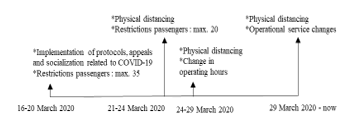 Figure 12: Preventive policy change
Figure 12: Preventive policy change
Beginning March 24, 2020, there will be a change in operating hours for the three Semarang – Bawen routes, namely early morning departures from 5:00 AM. to 9:00 AM., while going start at 3:00 PM. to 6:00 PM. from Tawang station and Bawen Terminal. The Semarang – Kendal route has an early departure at 5:30 AM and a late departure at 5:00 PM from Mangkang terminal and Bahurekso terminal, so the operational finish is at 6:00 PM. The Purwokerto – Purbalingga route departs early at 5:00 AM and late departures at 5:00 PM from the Bulupitu terminal and 4:45 PM from the Bukateja terminal so that operations completed at 6:00 PM until the Bulupitu terminal and Bukateja terminal. Even though there are changes in operating hours and loss in headway time, roundtrip trips per day remain. It is to anticipate restrictions on the number of passengers who not transported during peak hours. However, the business did not increase the operating ratio. March 29, 2020, operational service change services developed, especially e-payments. Notably, Semarang has implemented E-ticketing since 2019, while other routes are still under development in 2021. Especially for BRT Purwokerto – Purbalingga passengers, the factors of financing, convenience and traceability agree that the aspects applied in improving e-payment-based services [22].The policy stages carried out by paying attention to the relevant stakeholders. The roles and relationships of stakeholders must link public health and transport policymakers [23].
5. Conclusion
The operational performance of BRT before the pandemic for the Semarang – Bawen and Purwokerto-Purbalingga routes were already above 70 per cent, has the opportunity to increase the number of new fleets, while Semarang – Kendal at 60 per cent has no chance. The pandemic caused a drastic drop in the load factor and operating ratio as an economic indicator. The low operating ratio during the pandemic and new normal life causes BRT operations to be unsustainable. High operating costs are not worth the income received. It will be even heavier if the operator opens a new route. The efforts made by the BRT operator to control the transmission of Covid-19 through the implemented health protocol had an impact on increasing the value of the load factor and operating ratio, even though it was below the standard, should be appreciated. The government and BRT operator play a role in restoring the performance of a healthy transportation system competent to serve community mobility well, especially in small and medium-sized cities.
Acknowledgment
Thank you to the Transportation Office of Central Java Province for assisting in obtaining the necessary secondary data.
- X. Zhang, Q. Zhang, T. Sun, Y. Zou, H. Chen, “Evaluation of urban public transport priority performance based on the improved TOPSIS method: A case study of Wuhan,” Sustainable Cities and Society, 43, 357–365, 2018, doi:10.1016/j.scs.2018.08.013.
- A. Tirachini, O. Cats, “COVID-19 and public transportation: Current assessment, prospects, and research needs,” Journal of Public Transportation, 22(1), 1–34, 2020, doi:10.5038/2375-0901.22.1.1.
- N. Huy Nghia, T. Sy Sua, N. Minh Hieu, “Evaluating the maiden BRT corridor in Vietnam,” Transport and Communications Science Journal, 71(4), 336–346, 2020, doi:10.25073/tcsj.71.4.3.
- BPS Jawa Tengah, Provinsi Jawa Tengah dalam Angka 2021, BPS Jawa Tengah, Semarang, 2021.
- R.T. Sataloff, M.M. Johns, K.M. Kost, Kabupaten Banyumas dalam Angka 2021, BPS Banyumas, Banyumas, 2021.
- M. Arimura, T.V. Ha, K. Okumura, T. Asada, “Changes in urban mobility in Sapporo city, Japan due to the Covid-19 emergency declarations,” Transportation Research Interdisciplinary Perspectives, 7, 100212, 2020, doi:10.1016/j.trip.2020.100212.
- L. Prayogi, “Bus Rapid Transit system’s influence on urban development: An inquiry to Boston and Seoul BRT systems’ technical characteristics,” IOP Conference Series: Earth and Environmental Science, 126(1), 2018, doi:10.1088/1755-1315/126/1/012047.
- T. Satiennam, A. Fukuda, “A Study On The Introduction Of Bus Rapid Transit System In Asian Developing Cities,” International Association of Traffic and Safety Sciences, 30(2), 59–69, 2006, doi:10.1016/S0386-1112(14)60170-9.
- Juanita, B. Prastio, “Kajian Efektifitas Halte Bus BRT Transjateng Purwokerto,” in Simposium Nasional Teknologi Infrastruktur Abad ke 21 UGM, 482–487, 2021.
- P. Bucsky, “Modal share changes due to COVID-19: The case of Budapest,” Transportation Research Interdisciplinary Perspectives, 8, 2020, doi:10.1016/j.trip.2020.100141.
- D.S. Pawar, A.K. Yadav, N. Akolekar, N.R. Velaga, “Impact of physical distancing due to novel coronavirus (SARS-CoV-2) on daily travel for work during transition to lockdown,” Transportation Research Interdisciplinary Perspectives, 7, 100203, 2020, doi:10.1016/j.trip.2020.100203.
- H. Kawaguchi, K. Kuromizu, S. Yagi, “A Minibus Supply Control Measure in Indonesia,” in 13th WCTR, July 15-18, Rio de Janeiro: 1–15, 2013.
- Suwardo, “the Determination of Bus Service Frequency Using Cost-Benefit Approach,” Jurnal Transportasi, 11(1), 29–38, 2011.
- GTZ, Bus Regulation and Planning, 2004.
- N. Fearnley, “Free Fares Policies?: Impact on Public Transport Mode Share and Other Transport Policy Goals,” International Journal of Transportation, 1(1), 75–90, 2013, doi:10.14257/ijt.2013. 1.1.05.
- T. Litman, Evaluating Public Transit As An Energy Conservation and Emission Reduction Strategy, Victoria Transport Policy Institute, 2012.
- A. Susilo, C.M. Rumende, C.W. Pitoyo, W.D. Santoso, M. Yulianti, H. Herikurniawan, R. Sinto, G. Singh, L. Nainggolan, E.J. Nelwan, L.K. Chen, A. Widhani, E. Wijaya, B. Wicaksana, M. Maksum, F. Annisa, C.O.M. Jasirwan, E. Yunihastuti, “Coronavirus Disease 2019: Tinjauan Literatur Terkini,” Jurnal Penyakit Dalam Indonesia, 7(1), 45, 2020, doi:10.7454/jpdi.v7i1.415.
- A. Tardivo, A. Carrillo Zanuy, C. Sánchez Martín, “COVID-19 Impact on Transport: A Paper from the Railways’ Systems Research Perspective,” Transportation Research Record: Journal of the Transportation Research Board, 036119812199067, 2021, doi:10.1177/0361198121990674.
- K. Gkiotsalitis, O. Cats, “Public transport planning adaption under the COVID-19 pandemic crisis: literature review of research needs and directions,” Transport Reviews, 0(0), 1–19, 2020, doi:10.1080/01441647.2020.1857886.
- D. Susanna, “When will the COVID-19 pandemic in indonesia end?,” Kesmas, 15(4), 160–162, 2020, doi:10.21109/KESMAS.V15I4.4361.
- Peraturan Menteri Perhubungan RI No PM 18, Pengendalian Transportasi Dalam Rangka Pencegahan Penyebaran Corona Virus Disease 2019 (COVID-19), Nomor 9(Pedoman Pembatasan Sosial Berskala Besar dalam Rangka Percepatan Penanganan Corona Virus DIsease 2019 (COVID-19)), 1–71, 2020.
- F. Romadlon, R.D. Lestari, F. Lestiana, N.A. Putri, “Kajian Pra-Implementasi Aplikasi Layanan pada Bus Rapid Transit Purwokerto-Purbalingga: Perspektif Penumpang Wanita,” Warta Penelitian Perhubungan, 32(2), 68–76, 2020, doi:10.25104/warlit.v32i2.1318.
- J. Zhang, “Transport policymaking that accounts for COVID-19 and future public health threats: A PASS approach,” Transport Policy, 99, 405–418, 2020, doi:10.1016/j.tranpol.2020.09.009.


